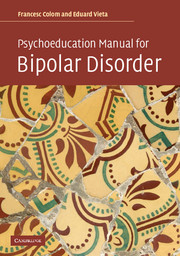Book contents
- Frontmatter
- Contents
- Foreword
- Preface
- Part 1 Clinical, diagnostic, and therapeutic aspects of bipolar disorders
- Part 2 Concept and methodology of psychoeducation
- Psychological treatment and bipolar disorders: why psychoeducate?
- Mechanisms of action of psychoeducation
- Integrating psychoeducation in clinical practice
- When to introduce psychoeducation?
- Formal aspects of the psychoeducation program
- Part 3 Psychoeducation program: sessions and contents
- Bibliography
- Index
When to introduce psychoeducation?
from Part 2 - Concept and methodology of psychoeducation
Published online by Cambridge University Press: 06 January 2010
- Frontmatter
- Contents
- Foreword
- Preface
- Part 1 Clinical, diagnostic, and therapeutic aspects of bipolar disorders
- Part 2 Concept and methodology of psychoeducation
- Psychological treatment and bipolar disorders: why psychoeducate?
- Mechanisms of action of psychoeducation
- Integrating psychoeducation in clinical practice
- When to introduce psychoeducation?
- Formal aspects of the psychoeducation program
- Part 3 Psychoeducation program: sessions and contents
- Bibliography
- Index
Summary
Introducing a psychological treatment can represent a great advance in the treatment of our patients, or a resounding failure with regrettable consequences, especially if it is the first time we try such a strategy. In the same way poor pharmacological adherence presented by some bipolar or schizophrenic patients can be explained, in some cases, by the unhappy experiences from the side effects suffered the first time they took antipsychotic drugs. For example, the first contact between a patient and a psychological treatment can be crucial in explaining the subsequent response to treatment. We are not now going to digress into mysteries of other paradigms about whether or not to shake hands with our patients and look them in the eye. In principle, they are your hands, your patients and your eyes, so do whatever common sense tells you. We, the authors of this book, are polite and we shake hands with someone when we greet them, and in principle we see no problem with looking anyone in the face. Moreover, we have enough assertiveness to maintain a suitable visual contact with our patients. When we refer to the first contact with the patient, we mean the moment when the psychological approach is introduced and the way in which it is presented to the patient.
If we limit ourselves to psychoeducation, it is completely reasonable to begin treatment when the patient is euthymic. A manic patient should absolutely not be introduced into a psychoeducation group.
- Type
- Chapter
- Information
- Psychoeducation Manual for Bipolar Disorder , pp. 40 - 44Publisher: Cambridge University PressPrint publication year: 2006

